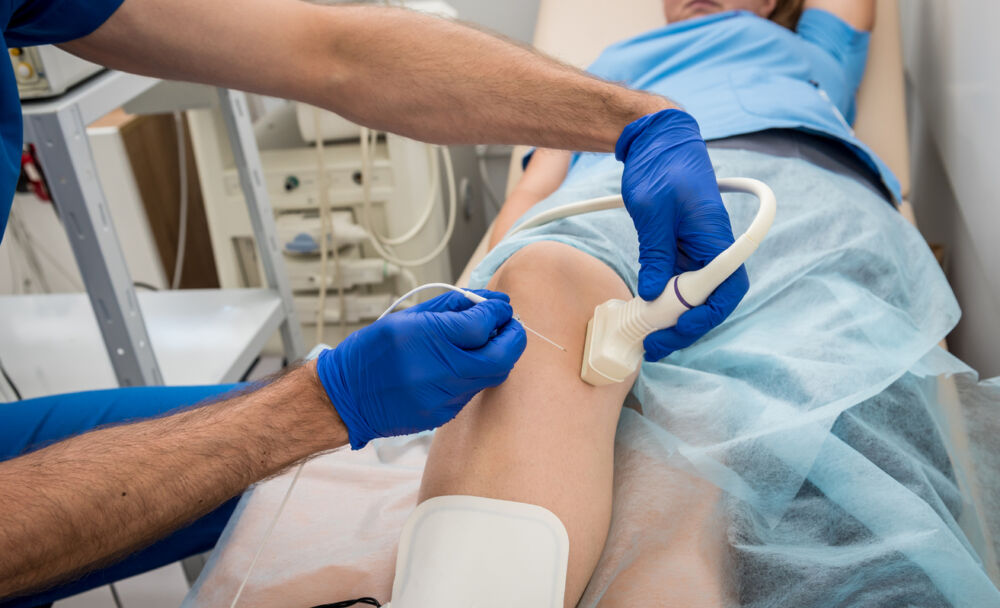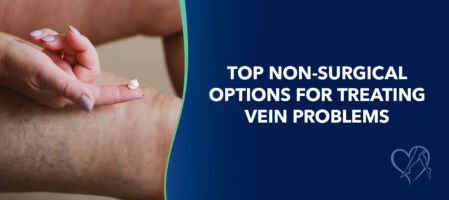
Does Radiofrequency Ablation Work?
The minimally invasive RFA procedure is a very successful treatment for varicose veins.

Varicose veins are enlarged, twisted, and bulging veins that typically appear on the legs and feet. They develop when the tiny, one-way valves inside the veins weaken or fail, allowing blood to flow backward and pool in the vein. This increased pressure causes the veins to stretch, twist, and become visibly swollen beneath the skin.
Having varicose veins can be a cosmetic-only issue for some people, causing them little discomfort outside of self-consciousness about the appearance of their legs. However, many others have a far more painful experience. Symptoms include:
Although office-based, minimally invasive vein treatments are available, some prefer to try non-surgical options like home remedies and lifestyle changes to find relief. While these may provide some temporary relief, they do not address the root cause—chronic venous insufficiency, a progressive condition caused by faulty vein valves. Only a board-certified vein specialist can accurately and effectively diagnose and treat vein disease.

At Center for Vein Restoration, the nation’s leader in vein care, our board-certified vein specialists use the latest minimally invasive treatments to help you feel and look your best. Don’t let vein disease hold you back. Schedule a consultation today and take the first step toward healthier legs! Call 240-965-3915 to speak to a Patient Services Representative or schedule your consultation online at a CVR near you today.
In this blog, we will explain the cause of varicose veins, ways to address problem veins without surgery, and minimally invasive outpatient treatment options for varicose veins to consider if you want safe, effective, permanent relief.
Before discussing solutions, let’s first explore what causes leg vein problems. The veins in your legs carry blood back to your heart. These veins contain one-way valves that prevent blood from flowing backward. When these valves weaken or fail, blood pools in the veins, leading to venous insufficiency (vein disease).
Venous insufficiency can cause:
If left untreated, vein disease can worsen over time. That’s why addressing the problem early with effective non-surgical vein treatments is essential.
Are aching, swollen legs making it hard to enjoy daily life? You don’t have to suffer in silence. Center for Vein Restoration (CVR) offers state-of-the-art vein treatments that provide lasting relief from varicose veins, spider veins, and venous insufficiency. All procedures are done in a comfortable outpatient setting. Our expert vein doctors will customize a treatment plan that works for you.
Book your appointment today and experience the difference that expert vein care can make!

While non-surgical methods may not eliminate varicose veins, they can reduce symptoms and slow disease progression. Here are the most common at-home treatments:
Exercise
Low-impact aerobic exercises such as walking, swimming, and biking gently work the calf muscles, helping veins push blood back toward the heart. If you work at a job where you sit or stand for long hours, taking frequent breaks to walk around stimulates circulation and reduces swelling.
Watch Your Diet
A healthy diet supports vein health by improving circulation and reducing inflammation. Here’s what to eat and avoid:
✔ Limit salt intake – Too much sodium causes water retention, worsening leg swelling.
✔ Eat potassium-rich foods – Leafy greens, potatoes, salmon, and tuna help flush excess water.
✔ Load up on flavonoids – Bell peppers, onions, citrus fruits, and spinach strengthen blood vessels.
✔ Increase fiber intake – Nuts and whole grains support digestion and prevent constipation, which can strain the veins.
Elevate Your Legs
Propping up your legs above heart level for 15-20 minutes several times a day reduces swelling and discomfort. This position helps the veins drain blood more effectively.
Wear Compression Stockings
Compression stockings apply gentle pressure to the legs, encouraging blood flow back to the heart. A study reported by the National Library of Medicine (NIH) found that patients wearing compression stockings reported symptom improvement. Further, the findings suggest progressive compression may be a more effective non-surgical treatment for CVD symptoms. A vein specialist can prescribe medical-grade compression socks for severe symptoms.
While at-home treatments can temporarily manage symptoms, they do not eliminate varicose veins. If you want a long-lasting solution, consider minimally invasive medical treatments performed in-office by a vein doctor. These outpatient procedures use only local anesthetics and require little to no downtime. Patients can drive home from these procedures and return to work and other activities immediately.
NOTE: Only a board-certified vein doctor can determine the right treatment for you.
1. Sclerotherapy
Best for: Spider veins and small varicose veins.
Sclerotherapy involves injecting a medical solution into diseased veins, causing them to collapse and fade. The body naturally absorbs the treated veins, rerouting blood through healthier ones.
According to the Mayo Clinic, sclerotherapy is highly effective for treating spider veins and typically requires minimal downtime.
2. Endovenous Laser Ablation (EVLA) and Radiofrequency Ablation (RFA)
Best for: Large varicose veins and venous insufficiency.
EVLA and RFA use heat energy to seal off diseased veins, eliminating leg pain, swelling, and discomfort. According to the National Library of Medicine (NIH), these techniques have success rates above 95 percent and offer quick recovery times.
3. VenaSeal™ (Medical Adhesive Closure)
Best for: Large varicose veins and venous insufficiency.
VenaSeal™ uses a medical-grade adhesive to close diseased veins. Unlike thermal treatments, it doesn’t require tumescent anesthesia or compression stockings post-procedure.
According to the American Vein and Lymphatic Society, as reported by the NIH, VenaSeal™ is a safe and effective alternative for patients seeking a comfortable, needle-free procedure.
Many over-the-counter creams and herbal supplements claim to cure varicose veins, but there is little scientific evidence to support these claims.
Herbs such as horse chestnut, grape seed, sea pine, and butcher’s broom may reduce discomfort, but they do not eliminate diseased veins. Additionally, grape seed extract can increase bleeding risk if taken with blood thinners.
Vein disease is a progressive condition, meaning it won’t go away on its own. If left untreated, symptoms worsen, potentially leading to complications such as skin ulcers or deep vein thrombosis (DVT). Visiting Center for Vein Restoration (CVR)—an Intersocietal Accreditation Commission (IAC) Accredited Vascular Lab—ensures you receive expert care from a trained vein doctor in a nationally recognized, high-quality facility.
A board-certified vein specialist can:
While exercise, diet, and compression stockings can help manage some symptoms of vein disease, home remedies are not a solution and won’t stop vein disease from progressing. If you’re looking for a permanent solution to varicose veins, it’s time to visit Center for Vein Restoration. Our cutting-edge treatments are performed in-office with little to no downtime.
Don’t wait—schedule your consultation now and take control of your vein health! Call 240-965-3915 to speak to a Patient Services Representative or follow the link below. Your legs will thank you!
